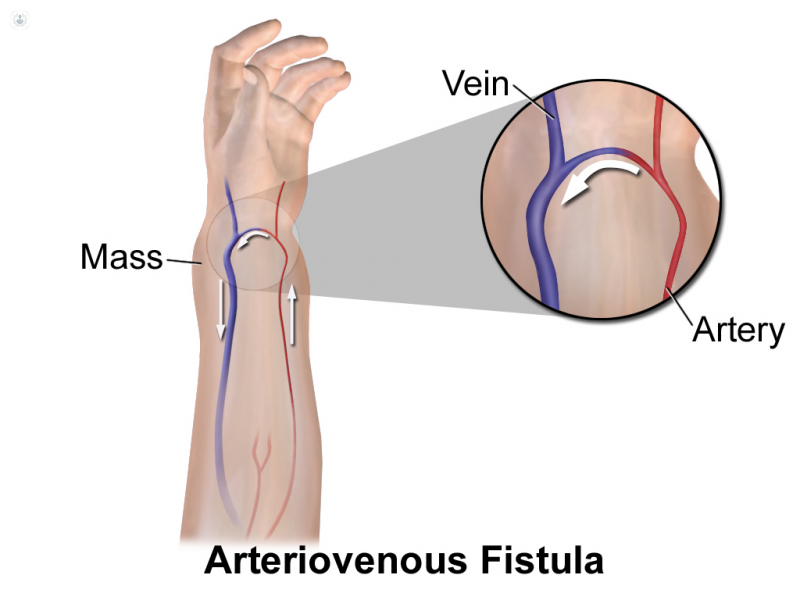Arteriovenous fistula
Mr Paritosh Sharma - Vascular surgery
Created on: 06-27-2013
Updated on: 09-20-2023
Edited by: Carlota Pano
What is an arteriovenous fistula?
An arteriovenous fistula is when an artery connects directly to a vein. This is an abnormality, as blood usually flows from arteries into smaller capillaries, where the oxygen and nutrients carried by the blood can be distributed to tissues, before passing into the veins. If these capillaries are bypassed by the fistula, the blood supply to nearby tissues is decreased, depriving them of sufficient oxygen and nutrients.
Arteriovenous fistulas can occur anywhere in the body, but tend to occur in the legs. Untreated fistulas can lead to serious complications.
In patients who have severe kidney disease, a surgeon may create an arteriovenous fistula for dialysis. This must be monitored by the patient’s doctor.

Symptoms of an arteriovenous fistula
Large arteriovenous fistulas can cause symptoms such as:
- large, purplish veins that you can see through the skin which may be similar in appearance to varicose veins
- low blood pressure
- swelling in the limbs
- Fatigue
- heart failure
Arteriovenous fistulas occurring in the lungs are very serious and can cause:
- coughing up blood
- a blue hue in the skin
- clubbing of fingers
Gastrointestinal arteriovenous fistulas may cause bleeding within the digestive system.
Small arteriovenous fistulas usually cause no symptoms and may not require treatment. However, they should be monitored by your doctor once they have been discovered.
Medical tests to diagnose an arteriovenous fistula
If your doctor suspects an arteriovenous fistula, they will first listen to the blood flow in the suspected location of the fistula with a stethoscope, as blood flowing through a fistula makes a characteristic humming or clicking sound.
The doctor may then order further tests, such as:
- Duplex ultrasound
- CT angiogram – a CT scan using a special contrast dye to make the blood vessels more easily visible
- Magnetic resonance angiogram (MRA) – similar to a standard MRI scan, but using a special contrast dye to make the blood vessels more easily visible
What are the causes of an arteriovenous fistula?
Arteriovenous fistulas may be caused by a number of things:
- Congenital arteriovenous fistula – the patient is born with the condition. This may be due to arteries and veins not developing properly in the uterus.
- Genetic conditions – for example, Osler-Weber-Rendu disease (also known as hereditary haemorrhagic telangiectasia) causes abnormal development of blood vessels throughout the body, particularly in the lungs, and can cause pulmonary arteriovenous fistulas.
- Injuries – penetrating wounds, such as stab or gunshot wounds, can cause arteriovenous fistulas if the injury occurs where an artery and vein are side-by-side.
- Cardiac catheterisation – this procedure involves passing a catheter (a long thin tube) through the blood vessels to the heart. In rare cases, an arteriovenous fistula can occur during this procedure.
Arteriovenous fistulas occur more frequently in women than in men, and the likelihood of developing one increases with age. Other risk factors include:
- Hypertension
- High BMI (body mass index)
- Certain medications
Treatments for an arteriovenous fistula
Smaller arteriovenous fistulas may not require treatment, especially if they are not causing any other health problems. Some may even close by themselves. They should still be monitored by a doctor.
Larger arteriovenous fistulas will probably need treatment. Your doctor may recommend one of the following options:
- Catheter embolisation – X-rays and/or other imaging techniques are used to guide a catheter through an artery to the site of the fistula, where a small coil or stent is placed to redirect blood flow.
- Surgery – this may be required for particularly large arteriovenous fistulas that cannot be dealt with by catheter embolisation. The size and location of the fistula determines the type of surgery required.
- Ultrasound-guided compression – usually only used for arteriovenous fistulas in the legs that can be seen by ultrasound, this 10-minute procedure involves using an ultrasound probe to compress the fistula and block blood flow to the damaged vessels. However, it is only effective in around one in three cases.
Which type of specialist treats arteriovenous fistulas?
Vascular surgeons are usually responsible for treating arteriovenous fistulas, while radiologists may be enlisted to scan the patient during diagnosis and treatment.


